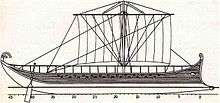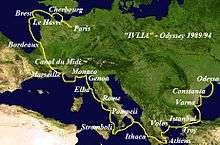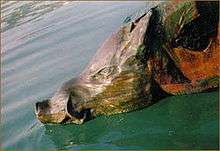Ivlia (ship)
.tif.jpg) Ivlia in Bay of Biscay | |
| History | |
|---|---|
| Name: | Ivlia |
| Laid down: | September 1988 |
| Launched: | August 1989 |
| Homeport: | Odessa 46°28′N 30°44′E / 46.467°N 30.733°E |
| General characteristics | |
| Type: | bireme |
| Displacement: | 26 tonnes |
| Length: | 25.4 m (83 ft 4 in) |
| Beam: | 4.6 m (15 ft 1 in) |
| Draught: | 0.8 m (2 ft 7 in) |
| Propulsion: |
|
| Speed: | Maximum (with oars) 5 knots (9.3 km/h) |
| Complement: | 50 plus 3 officers (in antiquity) |
| Armament: | bronze bow ram.[note 1] |
Ivlia (bireme) is a modern reconstruction of an ancient Greek rowing warship (galley) with oars at two levels and an important example of experimental archaeology. Between 1989 and 1994, this vessel undertook six comprehensive international historical and geographical expeditions in the footsteps of the ancient seafarers.[note 2]
Ship construction
The main sponsor of construction of the ship was the Black Sea Shipping Company.[note 3]



The ship was constructed in 1989 at the Sochi Naval Shipyard,[note 4] by a team under shipwright Damir S. Shkhalakhov, as well as the active participation of the future crew members. Ivlia was built from Durmast oak and Siberian larch, the oars are of beech. Technical design of the project was carried out by specialists of the Nikolayev University of Shipbuilding.[1] After processing the available scientific data (ancient illustrations on vases and reliefs, written and archaeological sources) members of the Odessa Archaeological Museum, under the leadership of prof. PhD Vladimir N. Stanko, proposed the building of a bireme since in antiquity it had been the most widely used vessel in the northern Black Sea region.

Expedition route
Starting from Odessa (Ukraine) in 1989, Ivlia followed the routes of the ancient mariners on the Black Sea and the Mediterranean as well as the Atlantic, covering more than 3.000 nautical miles in six expedition seasons and visiting over 50 European ports, finally sailing up the river Seine to reach Paris.[note 5] The expedition's progress was widely covered by the international media.[note 6] During the time of the voyage, hundreds of articles were published, along with dozens of TV and radio reports. The ship was regularly visited by official delegations and thousands of tourists. Ivlia also took part in international maritime festivals: «Colombo'92» (Genoa, Italy), «Brest’92», «Cancal’93», «Whitbread Round the World Race '93» (Portsmouth) «Vieux Greements’94» (France). The radio constantly broadcast the expedition’s call sign.[note 7] Over six seasons the crew members included more than 200 people – citizens of Russia, Ukraine, Moldova, France, Greece and Georgia.
Scientific aspects
The research programme of the expedition was developed by the authors of the project, together with the staff of the Odessa Archaeological Museum and the Nikolayev University of Shipbuilding, primarily to address the following objectives:
- Clarification of written and archaeological sources of data on the design, construction technology and load capacity of ancient Greek ships;
- Practical research into the seaworthiness of antique biremes. It is worth noting the high seaworthiness of the bireme, even with tailwinds of up to 7 on the Beaufort scale.[note 8]
- Verification of cabotage routes of Hellenic sailors, as well as the possibility of galleys in antiquity making voyages on the open sea, out of sight of the coast;[note 9]
- Clarifying the details of ancient periplus and verifying a range of hypotheses (from the project authors) to localise the ancient Greek settlement of the North-Western Black Sea region;
- Mastering the ancient art of navigation, control of an antique vessel by sail, methods of mooring and anchoring galleys;
The practical experience gained on Ivlia's expeditions enabled the project authors to affirm:
- The level of cartographical advancement and navigational knowledge of the ancient Greeks and the seaworthiness of their ships were far higher than is commonly believed;
- Ancient mariners were perfectly able to orient by the stars, made open sea crossings, were unafraid of sailing away from the coast, were familiar with and skilfully used the prevailing winds and currents;
- The famous triremes, which were distinguished by their outstanding performance in combat, were much less seaworthy than the biremes: they were built for battle and used in large naval campaigns;
- Biremes were the most common type of vessel used during the great Greek colonization of the Mediterranean. The geographical discoveries of antiquity were made on these vessels, suited as they were to long ocean voyages. As the most seaworthy ships of the time, it is most likely that biremes were used by the Carthaginian explorer Himilco, for Hanno the Navigator's explorations beyond the Pillars of Hercules, as well as Pytheas of Massalia's voyage to the legendary island of Thule.
In addition, the research programme conducted on board Ivlia included the participation of the Institute of Biology of the Southern Seas, the Institute of Water Transport Hygiene, and other scientific centres of Ukraine. During the expedition, regular measurements were made of environmental parameters and the level of pollution of the sea water, assessments of the state of marine flora and fauna, and a variety of medical experiments were conducted. The data obtained during the six years of voyages are summarized in the articles and books subsequently published by the authors of the project.[note 6] On the whole, Ivlia’s journey around Europe was a bright page in the study of Hellenic shipbuilding and seafaring, and also contributed to the strengthening of international cultural relations.
Notes
- ↑ In form of wild boar's head.
- ↑ International expedition "Black Sea".
- ↑ On all her voyages, Ivlia’s sail bore the acronym BLASCO – the logo of this shipping company.
- ↑ Soviet Naval Shipyard №1.
- ↑ To celebrate the successful completion of the voyages, on behalf of the Mayor of Paris the future President of France, Jacques Chirac, was received on board the Ivlia.
- 1 2 See Literature.
- ↑ RB5FH/mm.
- ↑ Even with no sails, Ivlia was able to maintain a stable course in stormy weather, solely as a result of windage from her high stern.
- ↑ In the scientific world, there is continuing debate about how far the routes of ancient mariners were from the coastline. Many scholars believe that ancient seagoing ships were weak, and consequently their pilots tacked close to the shores. However, a coast unlit and unequipped with navigation marks (as it was in ancient times), posed far more perils for navigation than the open sea. To this must be added the real threat of pirate attacks, since many of the coastal peoples engaged in brigandage.
References
- ↑ "Проектно-конструкторский Центр "ЯХТА" - проектирование парусно-моторных и моторных яхт". Yachts.mykolayiv.com. Retrieved 2014-01-03.
Literature
- Bockius, Ronald (2007). Schifffahrt und Schiffbau in der Antike, p. 52-64. Theiss Verlag. ISBN 978-3-8062-1971-5
- Casson, Lionel (1991). The Ancient Mariners, ch.8. Princeton University Press. ISBN 0-691-06836-4
- Gilles, Daniel (1992). L'Album Souvenir de la Fete Brest'92, p. 7, 111, 236, 257. Le Chasse Maree. Armen. ISBN 2-903708-37-1
- Mark, Samuel (2005). Homeric Seafaring, ch.4,5. Texas University Press. ISBN 1-58544-391-3
- Melnik, Igor K. (2010). Historical Maritime Sailing in Models & Reconstruktions, p. 46-49. Kiev, Phoenix. ISBN 978-966-438-278-3
- Morrison, John. The Athenian Trireme, p. 28 n.2. Cambridge University Press. ISBN 0-521-56419-0
- "Il Secolo XIX", (Italy), 23.05.1992. "In porto, dopo 3 anni d'odissea, una triremi russa", Giorgio Carrozi.
- "La Stampa", (Italy), 31.05.1992 (№147). "E'approdata a Sanremo la triremi dell'antica Grecia".
- "Il Tirreno", (Italy), 06.05.1992. " Una mostra per l’Ivlia".
- "Le Monde", (France), 19.07.1992. "Pavel, galerien d'Odessa", Annick Cojean.
- "Revue Thalassa", (France), 07.1992 (№3). "Et vogue la galere" p. 64-65.
- "Presse – Ocean (Ouest)", (France), 09.09.1994. "Ivlia se prepare pour une transatlantique", Severine Le Bourhis, p. 15.
- "Le Télégramme", (France), 02.08.1994. "La galere antique a la conquete de l’Atlantique", Noel Pochet.
- "La Presse de la Manche", (France), 14.08.1993. " Et vogue la galere ukrainienne", Th. Motte, p. 3-4.
- "Le Chasse Maree", (France), 07.1992 (№67). "Ivlia, la galere", p. 16.
- "Le Marin", (France), 21.05.1993. "Sous le vent de la galere", Cristhine Le Portal.
- "Le Parisien", (edition Paris), 16.09.1993. "Une galere antique", Laurent Mauron.
- "Libération", (France), 07.12.1993. "Ivlia ou l'Odyssee suspendue", Patrick Le Roux, p. 28-29.
External links
- http://www.ivlia.com/en.html
- http://history.marin.net.ua/index.php?option=com_content&view=category&id=46:-lr&Itemid=81
- http://www.xlegio.ru/navy/ancient-ships/to-the-question-of-ancient-seafaring/
- http://vokrugsveta.com/index.php?option=com_content&task=view&id=478&Itemid=69
- https://www.youtube.com/watch?v=gsJt1DbbDRo
- https://www.youtube.com/watch?v=I37WQpCH474
- https://www.youtube.com/watch?v=1LGH6Y87Mpg
- https://www.youtube.com/watch?v=-TEVfO39n_I
Coordinates: 37°56′3.3″N 23°41′7.14″E / 37.934250°N 23.6853167°E
